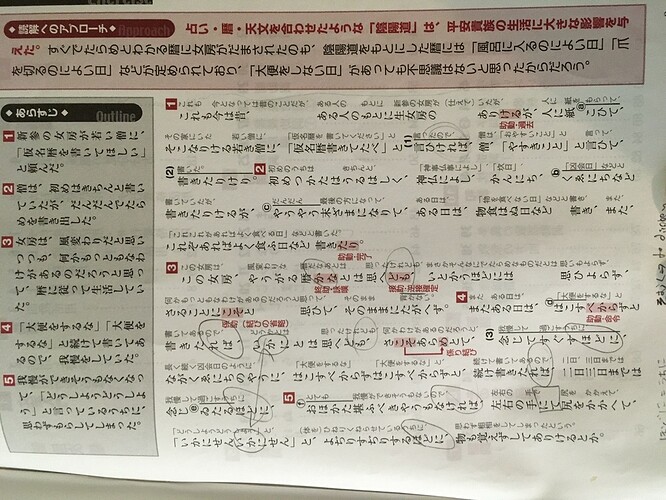WELCOME!
So I am kind of into Kobun right now. For those who don’t know, it’s the old way Japanese used to be written (until relatively recently, in fact!) and even spoken (that was a long time ago though). Essentially, even as the spoken language evolved, the writing system stayed the same for a long time. So that’s why much of the old literature in Japanese (even up until right before WWII) has words like 思ふ (which is just 思う)
I probably could have just taken a picture and uploaded it, but I instead copied the lesson and exercise from the Kobun book I am using. (ISBN 978-4-86066-287-5 if you are interested!). This book is made for native Japanese people studying Kobun, but pretty at a beginner level. That is to say, it’s a beginner level of KOBUN. The modern Japanese translations and explanations inside is relatively straight forward, but it’s not something a beginner in the language as a whole could grasp.
The great thing about this book is that is has you reading real pieces of Kobun right from the first lesson. I think the motive is that, you don’t need to understand everything right away. It’s important to see the patterns as they happen in real literature, and through reading the modern Japanese translations, and re-reading, and slowly building up bits and piece of grammar knowledge, one slowly becomes to able to actually read this stuff.
The first lesson is about how the way Kana was read differently back in the day. So I copied that and the excerpt directly from the book (heh). Hope you enjoy!
☆印歴史的仮名遣いの読み方☆
※ハ行 ------ は・ひ・ふ・へ・ほ ⇒ ワ・イ・ウ・エ・オ
原則=ハ行はワ行で読む
- 例
あはれ(哀れ)⇒ アワレ
かほ (顔)⇒ カオ例外=ハ行は語頭にある場合はそのまま読む
- 例
はな(花)⇒ ハナ
This just means that unless it’s at the beginning of a word, all はひふへほ sound like わいうえお
※ワ行------ ゐ⇒イ・ゑ⇒エ・を⇒オ
- 例
ゐど(井戸)⇒イド
ゑむ(笑む)⇒エム
Maybe you’ve seen these before. This just means that the old kana ゐゑ are pronounced いえ
※ダ行----- ぢ⇒ジ・づ⇒ズ
- 例
はぢ(恥)⇒ハジ
みづうみ(湖)⇒ミズウミ
This is relevant even now. ぢ and づ sound like じ and ず
※「くわ」「ぐわ」------ くわ⇒カ・ぐわ⇒ガ
- 例
くわじ(火事)⇒カジ
きぐわん(祈願)⇒キガン
This is wild. So くわ becomes か and ぐわ becomes が.
※ア段・イ段・エ段の仮名に「う」「ふ」がつく場合
- ~あう au (~あふ ahu) ⇒ ~オウ ou
- ~いう iu (~いふ ihu) ⇒ ~ユウ yuu (〜ュウ)
- ~えう eu (~えふ ehu) ⇒ ~ヨウ you (〜ョウ)
*実際には、〜の部分に子音がついて使われる。
例
まうす(申す)→モウス(mausu→mousu)
きふ(急)→ キュウ (kihu→kyuu)
けふ(今日)→キョウ (kefu→kyou)
This is the hardest, or easiest, one to remember, become it comes up so much. Especially with words like きふ(急) As it mentions, usually a consonant appears before the “au/iu/eu/afu/ifu/efu” so it could be like めう(妙)or しふ(集)
Here is the reading!
実践問題①
___これも今は昔、ある人のもとに生女房(なまにょうばう)のありけるが、人に紙こひて、そこなりける若き僧に、「仮名暦(かなごよみ)を書きてたべ」と言ひければ、僧、「やすきこと」と言ひて、書きたりけり。初めつかたはうるはしく、神仏によし、かんにち、くゑにちなど書きたりけるが、やうやう末(すゑ)ざまになりて、ある日は、物食はぬ日など書き、また、これぞあればよく食ふ日など書きたり。
___この女房、やうがる暦かなとは思へども、いとかうほどには思ひよらず、さることにこそと思ひて、そのままにたがへず。またある日は、はこすべからずと書きたれば、いかにとは思へども、さこそあらめとて、念じてすぐすほどに、ながくゑにちにやうに、はこすべからずはこすべからずと、続け書きたれば、二日三日までは念じゐたるほどに、おほかた堪ふべきやうもなければ、左右の手にて尻をかかへて、「いかにせんいかにせん」と、よぢりすぢりするほどに、物も覚えずしてありけるとか。
BOLD WORDS: (These are listed in the book as well. They are marked both for some historical insight, as well as to make the reading bearable. Especially important because the punchline of this story is hinging on a word you’ve probably never heard! はこす)
・今は昔 ー 今となっては昔のことだが。[MrBaman Note: This is just the old way of saying むかしむかしあるところに]
・生女房 ー 宮仕えにまだ慣れていない新参の女房(身の回りの世話をする侍女)
・そこなりける ー その家にいた
・仮名暦 ー 仮名書きの暦。一般に暦は漢字で書かれるものであったが、漢字を読める女性は少なかったため、ここでは仮名で書いた。
・書きてたべ ー 書いてください。「たべ」は「給べ」と書く。
・かんにち、くゑにち ー 陰陽道でよくないとされる日。
・やうがる ー 風変わりな
・いとかうほどには思ひよらず ー まさかそんなにでたらめなものだとは思いもよらず。
・さることにこそ ー 何かもっともなわけがあるのだろう。
・はこす ー 大便をする。
・さこそあらめ ー 何かわけがあるのだろう。
・いかにせんいかにせん ー どうしようどうしよう。
If you want I can add in a spoiler of the translation provided by the book.





